
The Evolution of Fashion As a Social Psychological Phenomenon
Fashion is more than just clothes. It is a way of expressing one’s personality. A fashion statement is an expression of a part of the person’s personality and tells the world something about their character. Whether it’s a bold new outfit or a simple change from the norm, everyone can be stylish by wearing the right clothing. It’s all about the way we choose to dress, from the colors to the fabrics.
As a social psychological phenomenon, fashion is constantly changing. It can evoke strong emotions or a sense of individual autonomy. It can refer to clothing, shoes, accessories, hairstyle, body posture, and makeup. It can also refer to a way of life. It implies a trending look, and everything that is considered “in” is in the fashion system. For example, fashion is used by celebrities to create a public image.
According to Malcolm Bernard, “fashion is the polar opposite of anti-fashion. It is fixed and not associated with a specific group, region, or culture. Fast-changing fashion often encourages unnecessary consumption and waste. However, many people enjoy this kind of diversity in their life and are attracted to it as a means of satisfying the desire for new experiences. Regardless of its negatives, fashion is a social psychological phenomenon that has become increasingly popular.
The evolution of fashion has influenced the world of style. Using the power of their influence, designers have taken advantage of the political climate of the U.S. presidential election to promote political causes. While these investments can benefit the bottom line, they limit the creativity of sponsored designers. Ultimately, this can homogenize fashion. The constant struggle between independent creativity and corporate investment has created a climate of unrelenting controversy. Throughout the 21st century, fashion has found itself at a precarious point in its evolution.
The concept of fashion and technology have long been a perfect match. These two industries are both future-oriented and consumer-oriented, and these two industries are gaining popularity at an increasing pace. For example, fashion and technology are now one and the same, and they have opened up the industry to people of all ages, income levels, and cultures. So, how do we define the best examples of these two fields? Let us look at some examples.
A fashion trend can be characterized as changing and adapting to its surroundings. Changing trends are essential to the evolution of the world’s culture and society, and this is why people are so apt to create a fashion statement. But not all of these trends are positive. They may actually be the opposite. This is because the current fashion of one region can be the exact opposite. This can lead to the development of a completely new style that will not appeal to another.
The fashion industry has evolved remarkably quickly in the past few decades. Its first digital appearance emerged in the mid-thirteenth century. In 2010, most fashion labels operated offline, but in the last decade, the entire industry has become increasingly online. Today, most fashion businesses combine their offline and online elements, which makes them more efficient in their marketing and distribution. But the traditional fashion industry still struggles with gathering data about its consumers. In contrast, it is a world that has many online and offline shops.